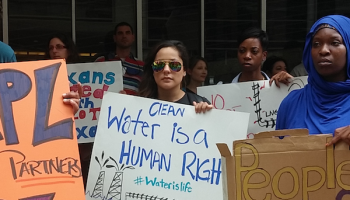Flame retardants pose exposure and health risks
Most flame retardant (FR) chemicals used in products like car seats are not strongly bound to the fabric or foam they are added to, so they easily migrate out and become airborne via dust. Human exposure may occur through breathing or ingesting dust and even through the skin.
A number of FRs are known endocrine disruptors and some are linked to cancer. Other FRs are lacking in toxicity information. Many FRs contain chlorine or bromine (these are called halogenated FRs because chlorine and bromine are halogens) and don’t break down easily in the environment. Chemical persistence can lead to bioaccumulation, the buildup of a substance in people and animals.
Although the historically used brominated FR chemicals called PBDEs have been phased out due to health concerns, we continue to find bromine in a large portion of children’s car seats. Decabromodiphenyl ethane, or DBDPE, for example, is common in vehicle interiors and was found in this year’s study of children’s car seats.1 DBDPE is highly persistent and bioaccumulative and exhibits developmental and other types of toxicity.2,3
Phosphorus-based FRs (PFRs) can be made without any halogens and have increased in popularity as the health and environmental concerns about halogenated FRs have grown. Triphenyl phosphate (TPHP) is one example of a widespread PFR that is used in some car seats. While eliminated from the body more quickly than other FRs, TPHP is nevertheless found extensively in the environment and accumulates in breast tissues.4 It exhibits hormonal and developmental toxicity.5–7
In addition to the specific FR chemistry mentioned above, flame retardants can be grouped by whether they are incorporated into chemical structures and how. We have produced a separate overview of polymeric FR, additive FR, and reactive FR.
Chemicals added to products should undergo toxicological assessment
Chemical hazard assessments should be completed on all FRs and other additives prior to their use in products. One option is Clean Production Action’s GreenScreen® For Safer Chemicals. This tool uses authoritative lists and trained assessors to determine the hazard profile of a substance. GreenScreen assessments for each of the major FRs found in 2018 and 2016 children’s car seats are in the tables below.
Phosphorus Flame Retardants
| Chemical Name | GreenScreen Assessment Score | Human Hazards | Environmental Hazards |
|---|---|---|---|
| Ammonium polyphosphate 68333-79-9 | Benchmark 3: Use but still opportunity for improvement |
|
|
| PMMMPs: Cyclic phosphonates 41203-81-0, 42595-45-9 | Benchmark unknown |
|
|
| RDP: Resorcinol bis(diphenyl phosphate) 125997-21-9 | Benchmark 2: Use but search for safer substitutes |
|
|
| TBEP: Tris(2-butoxyethyl) phosphate 78-51-3 | Possible Benchmark 1: Avoid |
|
|
| TEHP: Tris(2-ethylhexyl) phosphate 78-42-2 | Possible Benchmark 1: Avoid |
|
|
| TEP: Triethyl phosphate 78-40-0 | Benchmark unknown |
|
|
| TPHP: Triphenyl phosphate 115-86-6 | Benchmark 2: Use but search for safer substitutes |
|
|
Brominated Flame Retardants
| Chemical Name | GreenScreen Assessment Score | Human Hazards | Environmental Hazards |
|---|---|---|---|
| Brominated polystyrene 88497-56-7 | Likely Benchmark 1: Avoid |
|
|
| DBDPE: Decabromodiphenyl ethane 84852-53-9 | Benchmark 1: Avoid |
|
|
| HBCD: Hexabromocyclodecane 25495-98-1 | Likely Benchmark 1: Avoid |
|
|
| TBBPA: Tetrabromobisphenol A 79-94-7 | Likely Benchmark 1: Avoid |
|
|
| TBC: Tris(2,3-dibromopropyl isocyanurate 126-72-7 | Likely Benchmark 1: Avoid |
|
|
Other Flame Retardants
| Chemical Name | GreenScreen Assessment Score | Human Hazards | Environmental Hazards |
|---|---|---|---|
| Antimony Trioxide 1309-64-4 | Benchmark 1: Avoid |
|
|
| Melamine 108-78-1 | Possible Benchmark 1: Avoid |
|
|
References
1. Besis, A., Christia, C., Poma, G., Covaci, A. & Samara, C. Legacy and novel brominated flame retardants in interior car dust – Implications for human exposure. Environmental Pollution 230, 871–881 (2017).
2. Smythe, T. A. et al. Impacts of Unregulated Novel Brominated Flame Retardants on Human Liver Thyroid Deiodination and Sulfotransferation. Environ. Sci. Technol. 51, 7245–7253 (2017).
3. Nakari, T. & Huhtala, S. In vivo and in vitro toxicity of decabromodiphenyl ethane, a flame retardant. Environmental Toxicology 25, 333–338 (2010).
4. Kim, U.-J. & Kannan, K. Occurrence and Distribution of Organophosphate Flame Retardants/Plasticizers in Surface Waters, Tap Water, and Rainwater: Implications for Human Exposure. Environ. Sci. Technol. 52, 5625–5633 (2018).
5. Zhang, Q. et al. Potential Estrogenic Effects of Phosphorus-Containing Flame Retardants. Environ. Sci. Technol. 48, 6995–7001 (2014).
6. Isales, G. M. et al. Triphenyl phosphate-induced developmental toxicity in zebrafish: Potential role of the retinoic acid receptor. Aquatic Toxicology 161, 221–230 (2015).
7. Hendriks, H. S. & Westerink, R. H. S. Neurotoxicity and risk assessment of brominated and alternative flame retardants. Neurotoxicology and Teratology 52, 248–269 (2015).


